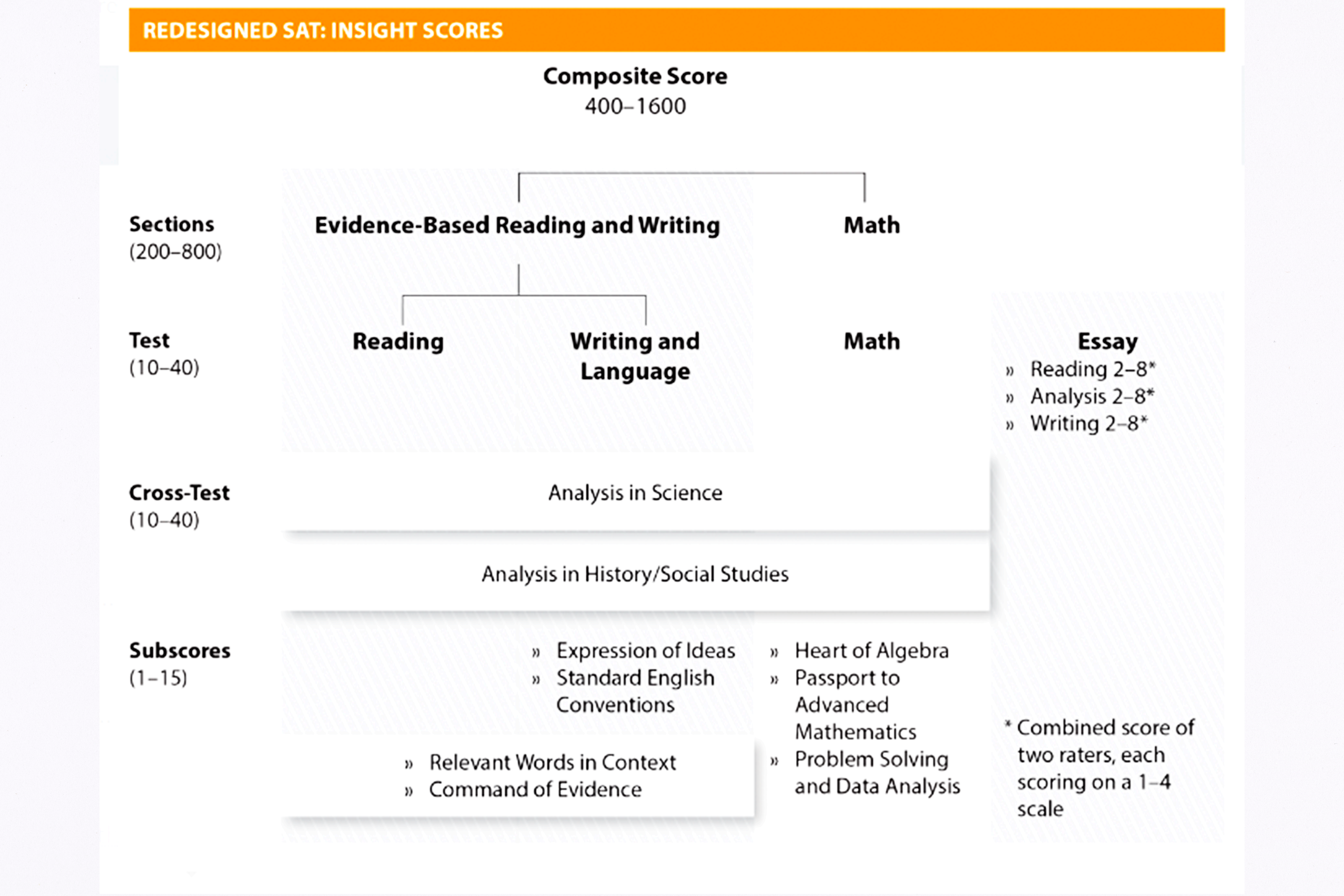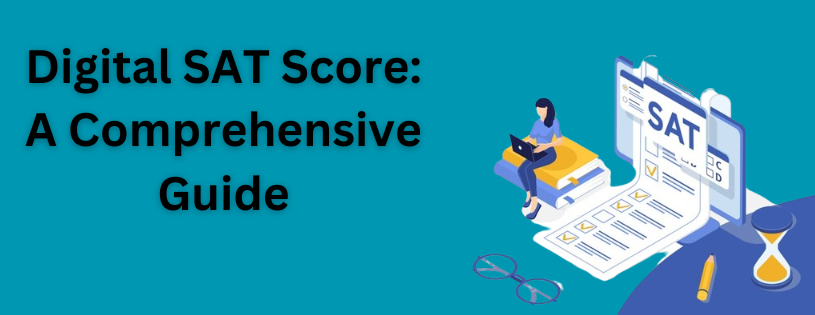Navigating the SAT Score: A Comprehensive Guide
The SAT, or Scholastic Assessment Test, is a pivotal examination that can significantly impact college admissions. Understanding how the SAT is scored is essential for test-takers aiming to achieve their best results. In this guide, we'll delve into the intricacies of SAT scoring, dissecting the total score, section scores, and additional insights provided on your SAT score report.

Explore the SAT Course Book a Free Trial Session
SAT Scoring Overview:
1. Total Score (400-1600):
- The total SAT score is the sum of two section scores: Math and Evidence-Based Reading and Writing (EBRW).
- The highest attainable score is 1600, with 400 being the lowest.
2. Section Scores (200-800):
- The Math and EBRW sections are each scored on a scale from 200 to 800.
- Achieving a balanced performance in both sections is crucial for a competitive total score.
Average SAT Scores for the Class of 2023:
- The average total SAT score for the class of 2023 was 1050.
- The average Math score was 521, and the average EBRW score was 529.
Your SAT Score Report:
1. Understanding the Sections:
- Your SAT score report details your total score and individual section scores.
- College admissions committees consider these scores when reviewing your application.
2. Cross-Test Scores (10-40):
- Analysis in History/Social Studies and Analysis in Science are two cross-test scores.
- They are based on selected questions from Reading, Writing and Language, and Math tests.
3. Subscores (1-15):
- Seven subscores evaluate specific proficiencies:
- Command of Evidence
- Words in Context
- Expression of Ideas
- Standard English Conventions
- Heart of Algebra
- Problem Solving and Data Analysis
- Passport to Advanced Math
Download PDF
SAT Percentiles Demystified:
1. Nationally Representative Sample Percentile:
- Compares your performance to all U.S. students in a specific grade, including those not typically taking the SAT.
- Reflects a broader demographic, potentially yielding a higher percentile due to the inclusive nature of the sample.
2. SAT User Percentile – National:
- Compares your performance against every college-bound SAT-taker in 11th or 12th grades.
- More focused on students intending to go to college and take the SAT.
Note: The Nationally Representative Sample Percentile tends to be higher because it includes a broader demographic, while the SAT User Percentile is more tailored to college-bound students.

Assessing Your Scores for College Admission:
Are Your Scores Good Enough for Your Dream School?
- Your SAT User Percentile is a more accurate measure of competitiveness for college admission.
- It doesn't include non-college-bound students, providing a clearer picture of how you stand among your college-bound peers.
Setting Target SAT Scores:
Learn How to Set Your Target Scores:
- Determine the SAT scores required by your dream school by researching their admission statistics.
- Consider the 25th and 75th percentiles of admitted students to set realistic goals.
Take a Free Practice Test:
- Gauge your potential performance by taking a free practice test.
- Obtain a detailed score report from reputable sources like The Princeton Review for a comprehensive analysis.
Expert Guidance for Your Next Move:
- Consult SAT experts to review your score report and strategize your preparation.
- The Princeton Review offers valuable insights to help you enhance your strengths and address areas for improvement.

SAT Score Choice | How Do They Work?
Confused about the inconsistency in your SAT test scores and worried about sending all the test scores to colleges or not? Then please don’t.
TestprepKart guides you through the policy called “Score Choice” and the advantages of using it.
What's the SAT Score Choice?
Score Choice is a program initiated by the College Board in 2009 to slash the stress in the test takers of SAT General & SAT Subject Test. Say that you’ve taken SAT multiple times, Score Choice allows you to send the best scores among your test scores to prospective colleges.
If you take the SAT in May, October, and December and you achieved your best score in December month, you can send all your three scores or December score alone to the prospective colleges. It’s entirely up to you to send the best score report you want and the bad scores to skip.
How Does Score Choice Work?
Score Choice policy is run online at the College Board website during the registration process. If you’ve no idea about the colleges during your registration, you can choose the free four-score reports option until the 9 days after your SAT registration deadline.
There’s a big con if you choose four free score reports during the registration. That is, you will be sending all your score reports to these 4 colleges (including the future tests that you haven’t taken yet or are about to take). So think twice before choosing the four free score reports. If you want to keep everything in control, don’t use these four free score reports.
Apart from these four free score reports, you have to pay $12 for each score report. If you’re eligible for SAT Fee Waiver, you can send as many score reports as you can for free.
If you don’t choose the Score Choice option, College Board will automatically send all your test score reports to your prospective colleges.
Score Choice is also beneficial for students taking the SAT Subject Test. If you are unsatisfied with your performance in May & October, you can again take them in December to leverage your test score.
When Should You Use Score Choice?
There are some schools that consider only your best score. If your previous test scores are blended with good and bad scores on SAT, Score Choice is the best solution you can opt for. For instance, you have done SAT three times in May, October, and December and the scores list is as follows:
|
Section
|
May
|
October
|
December
|
|
EBRW
|
560
|
670
|
760
|
|
Math
|
760
|
760
|
780
|
|
Total Score
|
1320
|
1430
|
1540
|
You’ve scored 1540 in the December test and it’s the best score among the three attempts. Then you will obviously send the December test score report to the prospective colleges. Sending the best score to the colleges will enhance your chances of admission. Colleges often consider a ton of components for offering undergraduate admission, but test score is the primary aspect.
Don’t take SAT/Subject Test more than 5-6 times and try to leverage your SAT scores as much as you can in these attempts.
Research About The Colleges
Research about the prospective college’s testing policy if they consider Score Choice or Superscore them. Check the SAT Superscore offering college list here (Updating Soon).
If you’re unsure about the college policy after checking their websites, call the admissions department. Consider this as an “impromptu interview” and the admission officer will make a note regarding your queries and place it in your admissions folder. Try to grab his attention with your politeness and inquisitiveness and make him feel that you’re extremely interested in their college. Such intentional acts will help you to get admission there.
Some colleges like Brown, Columbia, Harvard, University of Connecticut, and the University of Virginia Super score your test scores by choosing the best scores from each section regardless of the test dates. Check the colleges that Super score your test scores (Updating Soon)
Some colleges like Arizona State, Colorado State, and the University of Wisconsin want you to send the single best score. In this case, Score Choice is the ideal solution.
Some colleges like Duke, University of Pennsylvania, and Rice University encourage you to send all the test scores. They couldn’t stop you technically from using the Score Choice option. But they consider it as a matter of integrity and honesty in the college application that you’ll stick to their testing policies.
SAT eBook
It is very important to know minor to major facts when starting your preparation for an aptitude-based exam like SAT, with updates that can help with your SAT preparation.
We are pleased to announce the release of TestprepKart's free SAT study guide for the new SAT. This free SAT ebook gives you everything you need to know about the test, from content to content mastery, among the top practice goals you need.

Download SAT eBook
FAQS
Q. What is a good SAT score?
Ans. A good SAT score is subjective and depends on the colleges or universities you're applying to. Generally, a score above 1400 (out of 1600) is considered competitive, but it's crucial to research the average scores of the institutions you're interested in.
Q. What is the average SAT score?
Ans. As of my last knowledge update in January 2022, the average SAT score was around 1050. However, average scores can vary over time and may differ based on the specific test administration.
Q. When do SAT scores come out?
Ans. SAT scores are typically released around 10 days after the test date. However, the exact release date may vary, and it's advisable to check the College Board website for the most up-to-date information.
Q. What is the highest SAT score?
Ans. The highest possible SAT score is 1600, with 800 points each for the Math and Evidence-Based Reading and Writing sections.
Q. What time do SAT scores come out?
Ans. SAT scores are usually released in the early morning hours (Eastern Time) on the designated release date.
Q. What is the average score for the SAT?
Ans. The average SAT score, as mentioned earlier, is around 1050. However, this can change over time.
Q. How long does it take to get SAT scores?
Ans. SAT scores are usually released approximately 10 days after the test date.
Q. What is a perfect SAT score?
Ans. A perfect SAT score is 1600, achieved by scoring 800 on both the Math and Evidence-Based Reading and Writing sections.
Q. Is 1300 a good SAT score?
Ans. A score of 1300 is considered a decent score, but whether it's "good" depends on the specific colleges you're applying to. Some institutions may consider this a competitive score, while others may have higher average score expectations.
Q. How is the SAT scored?
Ans. The SAT is scored on a scale of 400 to 1600, combining scores from the Math and Evidence-Based Reading and Writing sections. Each section is scored between 200 and 800.


Post a Comment